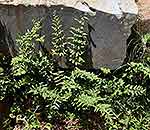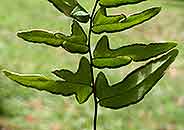Cheilanthes viridis (Forssk.) Sw. var. viridis
Synonyms |
Pellaea viridis (Forssk.) Prantl |
|---|---|
Common name |
|
Description |
Rhizome short, creeping, c.5 mm in diameter; rhizome scales linear-lanceolate in outline, apex slowly tapering to a point, margin entire, up to 3 mm long, brown to rust-coloured with dark brown central stripe. Fronds monomorphic, tufted or closely spaced, erect to arching, deep green, herbaceous to thinly coracious. Stipe up to 44 cm long, about as long as the lamina, dark brown to blackish, shiny, grooved in the upper part, practically hairless but set with hairlike scales towards the base. Lamina varying in size, shape and dissection; mostly 2-pinnate to 3-pinnate, rarely more divided; lower pinnae the largest and occasionally somewhat basiscopically developed, up to 10-50 × 2.5-28 cm, lanceolate to ovate to broadly triangular in outline; pinnae oblong, c. 2-10 x 2.5 cm; pinnules 5-9 pairs, variable, ovate-triangular or oblong-lanceolate to distinctly hastate in outline, apex rounded to pointed, base cordate to hastate, margin entire to minutely crenate, 1.5-8 x 0.6-2 cm, both surfaces hairless or slightly hairy on the veins; venation free, distinct; rhachis and secondary rhachis dark brown to black, shiny, broadly grooved, with pale chestnut wings, hairless or with hairlike scales, always pubescent in the axils. Sori marginal; indusium continuous, membranous, subentire or somewhat erose. |
Notes | Could be confused with C. quadripinnata which is more divided (lamina 4-pinnatifid to 5-pinnate), has strongly developed basiscopically basal pinnae and veins that are obscure on the upper surface.
C. virides var. glauca has a rhachis that is deeply grooved with a lighter coloured wing, the secondary rhachis and petiolules are hairless or set with filiform appressed scales.
|
Derivation | viridis: green, alluding to the green colour of the fronds |
Habitat | Undergrowth and margins of evergreen forest, among rocks in woodland. |
Distribution worldwide | Africa, also in Madagascar, Yemen, India, Cape Verde and Mascarene islands. |
Distribution in Africa |
Angola, Botswana, Burundi, Dem. Republic of Congo, Ethiopia, Kenya, Lesotho, Malawi, Mozambique, Namibia, Rwanda, Somalia, South Africa, Sudan and South Sudan, Swaziland, Tanzania , Uganda, Zambia, Zimbabwe. |
Growth form |
Lithophytic, terrestrial. |
Literature |
|


